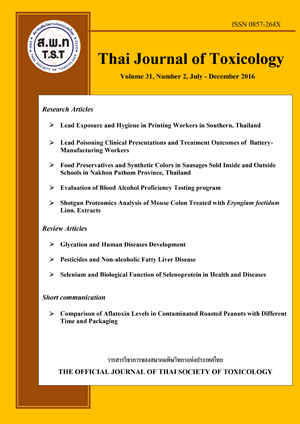ลักษณะทางคลินิกของโรคพิษตะกั่วและผลการรักษาในพนักงานโรงงานผลิตแบตเตอรี่
Main Article Content
บทคัดย่อ
ผลการตรวจสุขภาพของโรงงานผลิตแบตเตอรี่แห่งหนึ่ง พบว่าพนักงานร้อยละ 20 มีระดับตะกั่วในเลือด (BLL) สูงเกิน 40 ไมโครกรัมต่อเดซิลิตร การศึกษานี้มีวัตถุประสงค์เพื่อศึกษาลักษณะทางคลินิกของโรคพิษตะกั่วและผลสำเร็จของการรักษาโรคพิษตะกั่วในพนักงาน 170 คนที่มี BLL สูงเกิน 40 ไมโครกรัมต่อเดซิลิตร โดยแพทย์อาชีวเวชศาสตร์ โดยการใช้ 1) แบบสอบถามข้อมูลสุขภาพและอาการของโรคพิษตะกั่ว 2) ตรวจร่างกาย 3) ตรวจเลือด (BLL ความสมบูรณ์ของเม็ดเลือดและระดับ creatinine) ทำการรักษาโดยย้ายงานเพื่อลดการสัมผัสและ/หรือให้ยาขับตะกั่วชนิดกิน/ชนิดฉีดติดตาม BLL เป็นระยะผลการศึกษา พบว่าค่าเฉลี่ย BLL ของพนักงาน 170 รายเท่ากับ 69.3 ไมโครกรัมต่อเดซิลิตรพบอาการที่มีความชุกมากกว่าร้อยละ 20 ได้แก่ ปวดเมื่อยกล้ามเนื้อ อ่อนเพลีย ปวดข้อ ปวดศีรษะ เวียนศีรษะ และหลงลืมง่าย พบภาวะโลหิตจางร้อยละ 13.3 วิเคราะห์ correlation พบว่า ปัจจัยอายุ อายุงาน และค่า MCV มีความสัมพันธ์กันเชิงเส้นตรงในทางลบกับ BLL (p < 0.05) ส่วนค่า RDW ของเม็ดเลือดแดง มีความสัมพันธ์กัน เชิงเส้นตรงใน ทางบวกกับ BLL (p<0.05) วิเคราะห์ association พบความสัมพันธ์ระหว่างประวัติการเคยย้ายงานเนื่องจากตะกั่วสูง กับ BLL ในปัจจุบัน (p < 0.01) ผลการย้ายงานเพื่อลดการสัมผัสในเดือนแรก (n = 94) พบว่า BLL ลดลง 26.13 ไมโครกรัมต่อเดซิลิตร (p < 0.01) ผลการรักษาด้วยยากิน D-penicillamine นาน 4 เดือน (n = 45) พบ BLL ลดลง 17.8 ไมโครกรัมต่อเดซิลิตร (p < 0.01) ผลการรักษาด้วยยาฉีด CaNa2EDTA 1,000 มก. ต่อวัน นาน 3 วัน (n=7) พบ BLL ลดลง 7.9 ไมโครกรัมต่อเดซิลิตร (p = 0.01) ในสัปดาห์ที่ 6 หลังฉีดยา สรุปได้ว่า การย้ายงานเพื่อลดการสัมผัส เสริมด้วยการรักษาโดยยาขับตะกั่วชนิดกิน และ/หรือชนิดฉีด ทำให้รักษาโรคพิษตะกั่วจากการทำงานในโรงงานผลิตแบตเตอรี่ได้สำเร็จ


